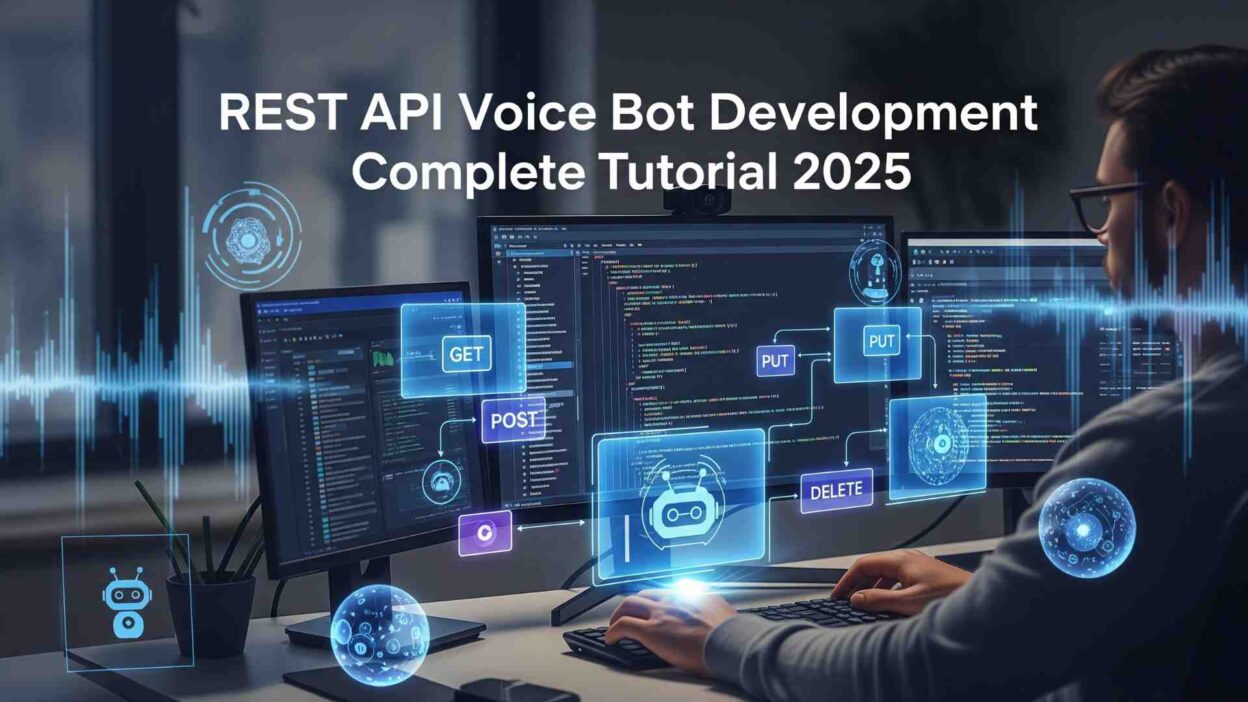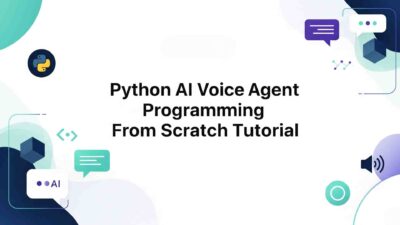TL;DR REST API voice assistant development has become the cornerstone of modern AI calling development for businesses seeking intelligent automation solutions. Every REST API voice assistant requires careful planning and systematic implementation for optimal performance. This comprehensive guide covers everything business leaders need to understand about creating production-ready voice automation programming systems in 2025. Voice assistants powered by REST APIs transform customer interactions and streamline business communications effectively.
Table of Contents
Modern enterprises require sophisticated voice solutions that integrate seamlessly with existing business systems. Building a REST API voice assistant eliminates traditional phone system limitations while providing scalable customer engagement platforms. Voice automation programming creates opportunities for businesses to enhance customer experiences significantly.
Understanding REST API Voice Assistant Architecture
REST API voice assistant systems consist of several interconnected components that work together seamlessly. Every REST API voice assistant implementation follows similar architectural patterns for optimal functionality. Speech recognition services convert customer voice input into readable text for processing. AI calling development requires robust text-to-speech capabilities for natural conversation flows.
The architecture includes communication endpoints for real-time interaction between voice platforms and business logic. Voice automation programming connects external services, databases, and third-party applications automatically. REST API voice assistant frameworks provide the foundation for scalable enterprise applications.
Core Components for AI Calling Development
Speech Recognition Engine: Modern REST API voice assistant platforms use advanced neural networks for accurate speech recognition. A professional REST API voice assistant handles various audio formats and quality levels automatically. Voice processing systems use tokens as units for analyzing input and generating output in conversations. AI calling development systems optimize resource usage for cost-effective operations.
Natural Language Processing: Voice automation programming requires sophisticated language understanding capabilities to interpret customer intent accurately. Each REST API voice assistant must process complex queries and provide relevant responses automatically. The system analyzes conversation context and maintains dialogue state throughout interactions. Advanced language processing enables natural communication flows.
Response Generation: AI language models generate contextually appropriate responses based on conversation history and business rules. Voice automation programming ensures responses match brand personality and communication standards. The system maintains conversation flow while handling interruptions and clarifications naturally.
Planning Your REST API Voice Assistant Development Strategy
Business Requirements and Goals
Development teams need clear objectives for modern voice automation programming projects. Building a REST API voice assistant requires understanding specific business needs and customer interaction goals. Organizations must identify which customer touchpoints will benefit most from voice automation. AI calling development environments include integration requirements for existing business systems.
Successful projects begin with comprehensive planning phases that outline technical specifications and business outcomes. Every REST API voice assistant project benefits from detailed requirement documentation that guides development decisions. Voice automation systems require secure infrastructure planning for handling sensitive customer data.
Choosing the Right Technology Stack
Professional REST API voice assistant implementations require selecting appropriate cloud service providers and voice processing technologies. Major technology providers offer comprehensive voice processing services including speech recognition and text-to-speech capabilities. Organizations can choose from multiple service providers based on language support, pricing models, and integration requirements.
Technology selection impacts system performance, scalability, and maintenance requirements significantly. A sophisticated REST API voice assistant supports multiple languages and voice personalities automatically. Voice automation programming platforms offer flexible deployment options including cloud-native and hybrid configurations.
Integrating Speech Services for Voice Automation Programming
Text-to-Speech Implementation
Modern text-to-speech services provide the foundation for REST API voice assistant implementations. Professional systems require direct service integration for maximum flexibility and control. Modern AI calling development leverages neural voice synthesis for natural-sounding speech output. Voice automation programming systems support multiple languages and regional dialects automatically.
Neural voice technology creates remarkably human-like speech patterns that enhance customer experiences. REST API voice assistant implementations can customize voice characteristics based on customer preferences and brand requirements. Organizations can select from hundreds of voice options across dozens of languages.
Speech-to-Text Integration
Voice automation programming requires accurate speech recognition capabilities for customer input processing. A well-designed REST API voice assistant handles various audio formats and quality levels automatically. AI calling development platforms provide real-time transcription with speaker identification features.
Modern speech recognition services support multiple languages and regional accents effectively. Voice automation programming systems can customize language models for industry-specific terminology and business vocabulary. REST API voice assistant development includes confidence scoring for transcription quality assessment.
Building Conversational AI Logic
Natural Language Understanding
Advanced language processing enables REST API voice assistant platforms to understand customer intent from transcribed speech automatically. Each REST API voice assistant must process complex queries and provide relevant responses based on business context. AI calling development systems analyze customer intent from voice conversations automatically.
Voice automation programming includes entity extraction, sentiment analysis, and conversation state management features. The system maintains dialogue context across multiple conversation turns effectively. REST API voice assistant platforms use large language models for context understanding and response generation.
Dialogue Management
Voice automation programming requires sophisticated dialogue management for natural conversation flows. Professional REST API voice assistant implementations require comprehensive conversation flow design and state management. AI calling development includes fallback strategies for handling unexpected customer responses and system errors.
The dialogue manager maintains conversation history and personalizes responses based on customer data and interaction patterns. Voice automation programming systems handle interruptions, clarifications, and topic changes seamlessly. REST API voice assistant platforms provide conversation analytics for continuous improvement and optimization.
Advanced Features for AI Calling Development
Real-Time Voice Processing
Modern AI calling development requires low-latency voice processing for natural conversation experiences. Voice automation programming systems process audio streams in real-time without buffering delays that disrupt conversation flow. REST API voice assistant platforms support bi-directional audio streaming for interactive customer conversations.
The technology eliminates traditional delays associated with batch audio processing methods. Real-time processing enables immediate responses and natural conversation timing. A sophisticated REST API voice assistant maintains conversation flow while processing complex customer requests simultaneously.
Integration with Business Systems
PreCallAI demonstrates how REST API voice assistant technology integrates with CRM systems and business databases seamlessly. AI calling development connects voice interactions with customer records and business processes automatically. Voice automation programming synchronizes conversation data across multiple business applications and platforms.
The integration enables personalized customer experiences based on historical interaction data and customer preferences. REST API voice assistant systems update customer records and trigger business workflows automatically. Integration capabilities provide comprehensive connectivity for third-party business systems.
Call Recording and Analytics
Voice automation programming includes comprehensive call recording and analysis capabilities for quality assurance and performance monitoring. Every REST API voice assistant project benefits from detailed conversation analytics and performance tracking. AI calling development platforms provide real-time dashboards for monitoring system performance and customer satisfaction metrics.
Analytics features help businesses optimize conversation flows and improve customer satisfaction rates continuously. Voice automation programming systems identify common customer issues and successful resolution patterns automatically. REST API voice assistant platforms support testing capabilities for conversation optimization strategies.
Production Deployment Best Practices
Scalability and Performance Optimization
Enterprise voice platforms demonstrate how to rebuild customer service operations using AI-native technology platforms. Professional REST API voice assistant implementations require horizontal scaling capabilities for handling peak call volumes effectively. AI calling development includes load balancing and auto-scaling features for production environments and high-traffic scenarios.
Production systems implement optimization strategies for frequently accessed data and common customer responses. Cloud voice processing API platforms use content distribution networks for global audio delivery and reduced latency. AI calling development includes database optimization for rapid customer data retrieval and response generation.
Security and Compliance
Voice automation programming requires comprehensive security measures for protecting customer voice data and sensitive information. A well-designed cloud voice processing API includes proper authentication, logging, and error handling mechanisms. AI calling development platforms comply with industry regulations including HIPAA, GDPR, and PCI DSS requirements.
Production deployments include authentication mechanisms for system access and user verification processes. Voice automation programming systems maintain audit trails for all customer interactions and system activities. Cloud voice processing API platforms provide data retention policies and secure deletion capabilities for regulatory compliance.
Monitoring and Error Handling
AI calling development requires sophisticated monitoring systems for tracking performance metrics and identifying system issues. Voice automation programming includes real-time alerting for system failures and performance degradation scenarios. Every cloud voice processing API system requires comprehensive logging for troubleshooting and performance optimization.
Error handling strategies include graceful degradation and fallback mechanisms for service disruptions and system failures. Voice automation programming systems implement retry mechanisms and circuit breakers for external service failures. Cloud voice processing API development includes comprehensive testing frameworks for quality assurance and system validation.
Testing and Quality Assurance
Automated Testing Strategies
Voice automation programming requires comprehensive testing frameworks for validating conversation flows and system responses. A sophisticated cloud voice processing API supports testing capabilities for optimizing customer interaction experiences. AI calling development platforms support automated testing with various voice inputs and conversation scenarios.
Testing frameworks validate speech recognition accuracy, response generation quality, and system performance under various load conditions. Voice automation programming includes regression testing for ensuring consistent behavior across software updates and system changes. cloud voice processing API systems support performance testing for optimizing conversation experiences and system reliability.
Performance Benchmarking
Modern voice development platforms enable developers to build real-time voice agents with performance optimization techniques. AI calling development requires latency benchmarking for ensuring responsive customer experiences and natural conversation timing.
Voice automation programming includes load testing for validating system capacity under peak usage conditions and high call volumes. Professional REST API voice assistant implementations require performance monitoring for response times, concurrent user capacity, and resource utilization metrics. Performance benchmarks help teams optimize system configurations and identify potential bottlenecks.
Future Trends in Voice Automation Programming
Multi-Modal Integration
Advanced voice platforms enable developers to build real-time voice agents powered by large language models for comprehensive customer service. Future cloud voice processing API systems will integrate speech, chat, video, and screen sharing capabilities seamlessly across multiple communication channels.
AI calling development will support omnichannel customer experiences with consistent conversation context and customer data. Voice automation programming will enable customers to switch between interaction methods without losing conversation history or context. Multi-modal integration creates comprehensive customer engagement platforms.
Enhanced AI Capabilities
Advanced language models will enable more sophisticated reasoning and problem-solving capabilities in voice assistant systems. Building a cloud voice processing API will include complex multi-step processes and decision-making workflows for comprehensive customer support. AI calling development will include emotional intelligence and empathy-driven responses for enhanced customer experiences and satisfaction.
Future voice automation programming will support autonomous problem resolution and complex business process automation. Cloud voice processing API platforms will integrate predictive analytics and proactive customer engagement capabilities. Enhanced AI will enable voice systems to anticipate customer needs and provide personalized recommendations.
Implementation Timeline and Project Planning
Phase 1: Planning and Design
Successful webhook voice assistant projects begin with comprehensive planning phases that define business objectives and technical requirements. Organizations should conduct thorough analysis of current customer interaction processes and identify optimization opportunities. Voice automation programming projects require detailed technical specifications and integration planning.
Project teams should establish clear success metrics and performance benchmarks for measuring voice assistant effectiveness. AI calling development timelines typically include planning, development, testing, and deployment phases spanning several months. Proper planning ensures smooth implementation and successful business outcomes.
Phase 2: Development and Integration
Development phases focus on building core voice processing capabilities and integrating with existing business systems. Professional webhook voice assistant implementations require systematic development approaches and rigorous testing procedures. Voice automation programming teams should implement features incrementally and validate functionality continuously.
Integration work connects voice systems with CRM platforms, databases, and other business applications seamlessly. AI calling development requires careful attention to data security and system performance throughout development cycles. Regular testing ensures voice assistants meet quality standards and business requirements.
Phase 3: Testing and Optimization
Comprehensive testing validates voice assistant functionality and performance under various conditions and usage scenarios. Every webhook voice assistant requires extensive quality assurance testing before production deployment. Voice automation programming testing includes conversation flow validation, performance benchmarking, and user experience assessment.
Optimization work fine-tunes voice recognition accuracy, response quality, and system performance based on testing results. AI calling development teams should conduct user acceptance testing with real customer scenarios and feedback collection. Testing phases ensure voice assistants deliver excellent customer experiences consistently.
Read More: Metaverse AI Avatars Handle Virtual Business Meetings
Conclusion

Webhook voice assistant development provides businesses with powerful tools for automating customer communications and enhancing service quality. This comprehensive tutorial covers essential concepts from basic setup to advanced production deployment strategies. AI calling development continues evolving with new technologies and capabilities that transform business communications.
Voice automation programming offers unlimited potential for businesses seeking competitive advantages through intelligent customer engagement. PreCallAI exemplifies how modern webhook voice assistant technology creates meaningful business value through automated phone conversations. Developers who master these techniques will build the next generation of intelligent business communication systems.
The future belongs to organizations that embrace voice automation programming for customer engagement and operational efficiency. Webhook voice assistant development skills become increasingly valuable as businesses recognize the potential of AI calling development. Start building your voice assistant today and transform how your business connects with customers.






[…] Read More: REST API Voice Assistant Development Complete Tutorial 2025 […]
[…] Read More: REST API Voice Assistant Development Complete Tutorial 2025 […]